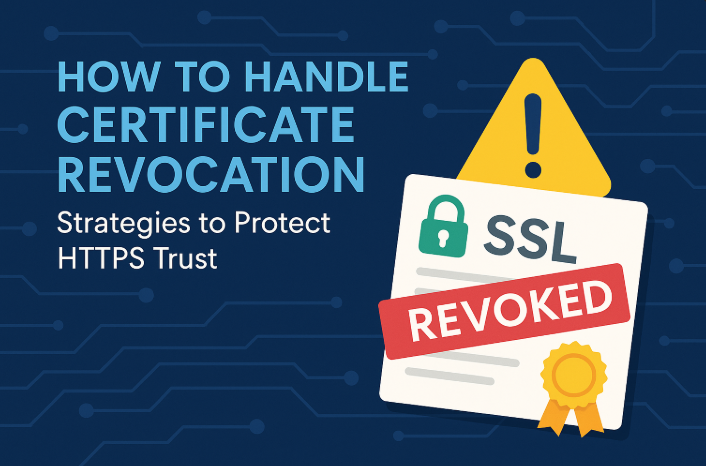
You’ve done everything right. SSL certificate? Installed. HTTPS? Locked and loaded. So why is your site still at risk? Because one piece of the puzzle is often ignored—certificate revocation.
Let’s get real—digital certificates are like digital passports. They’re what browsers use to trust that a website is actually who it claims to be. But what happens when that “passport” is compromised? Or stolen? Or just... outdated? That’s where certificate revocation comes in.
And here's the kicker: if revocation isn't handled right, users might still trust a broken or malicious connection.
So yeah, revocation is your silent security failover. Let’s break down how to do it right.
1. What is Certificate Revocation, Really?
Imagine lending someone your credit card and realizing they’ve lost it. Naturally, you'd call your bank and cancel it, right?
A revoked SSL certificate is the digital equivalent of cancelling a lost or compromised credit card. The certificate may still technically be valid, but you don’t want anyone trusting it anymore.
There are a few common reasons why certificates get revoked:
The private key was exposed or stolen.
The certificate was issued by mistake.
The domain ownership has changed.
You just no longer need it.
Once revoked, the certificate should no longer be trusted by browsers, users, or APIs. But whether that revocation is recognized and respected is a whole other story.
2. Why Revocation Is Tricky in the Real World
Here’s a head-scratcher: even if you revoke a certificate, that doesn’t guarantee browsers will check if it’s revoked.
That’s because the traditional methods of checking revocation—CRL and OCSP—have their flaws. Let’s go over them:
CRL (Certificate Revocation List)
This is the OG of revocation methods. The Certificate Authority (CA) keeps a list of revoked certificates, and your browser downloads that list.
The catch? CRLs are big, slow, and updated infrequently. Imagine checking a 200-page PDF every time you open a site.
OCSP (Online Certificate Status Protocol)
This one is more real-time. Your browser asks the CA, “Is this cert still good?”
The catch? If the CA server is slow or unreachable, browsers often just skip the check. Yup, they say: “No response? Let’s trust it anyway.” This is called soft-fail, and it’s as dangerous as it sounds.
OCSP Stapling
Now we’re getting somewhere. With OCSP stapling, the server includes a recent OCSP response during the TLS handshake. The browser doesn’t need to make a separate query.
It’s faster and safer—but only if it’s actually implemented.
3. Strategies for Proactive Revocation Management
Okay, we’ve trashed the old methods—what now? If you’re running a secure website, API, or platform, here’s what you can actually do:
A. Automate Certificate Monitoring
You can’t revoke what you don’t track. Set up monitoring tools to track certificate expiration, issuance, and revocation status. Bonus if they integrate with your CI/CD pipeline.
Tools to consider:
Certbot with hooks
Let’s Encrypt integrations
SSLMate or Cert Spotter
B. Implement OCSP Stapling
If you run Nginx or Apache, enable OCSP stapling. It’s the best real-time check you’ve got—and it's easy to set up.
For example, in Nginx:
nginx ssl_stapling on;ssl_stapling_verify on;
Don’t forget to ensure your certificates support OCSP.
C. Rotate Certificates Frequently
One neat trick is to rotate your SSL certs regularly—say, every 60-90 days. Let’s Encrypt does this by default.
Shorter-lived certificates reduce your exposure if something goes wrong. Think of it as changing your locks often.
D. Use CT Logs (Certificate Transparency)
Make sure your certs are publicly logged. That way, any suspicious issuance gets flagged fast. Platforms like crt.sh and Google Certificate Transparency help you monitor certs issued in your name.
4. Advanced Revocation Techniques for Large Deployments
If you're operating a CDN, enterprise API gateway, or cloud load balancer, certificate revocation becomes a more complex beast. Here’s how to level up:
A. Integrate with Internal PKI
If you manage internal certs (e.g., for microservices), integrate revocation into your internal PKI system. Automate OCSP response distribution to all services.
B. Distribute via CDN
If you’re serving millions of clients, cache OCSP responses on your CDN edge nodes. This reduces CA query load and makes revocation checks blazing fast.
C. Flag Mismatches via Client-Side JS or CSP
Worried that users are still seeing revoked certs? Use JavaScript error logging or Content Security Policy (CSP) reporting to catch failed cert validations on the client side.
5. What Happens When Revocation Fails?
Let’s play out the worst-case scenario.
You revoked your cert after a compromise, but your users are still connecting to the site. Maybe their browser skipped the check. Maybe your server didn’t staple the OCSP response. Maybe your CDN cached the old cert.
Result? Your traffic is still vulnerable. Your brand still gets hit. And you’re left wondering, “Didn’t I revoke that thing?”
That’s why revocation isn’t just a checkbox. It’s a process, and like any good process, it needs end-to-end visibility, automation, and testing.
6. The Future of Certificate Revocation
Good news? Revocation is finally getting the attention it deserves.
Trends to watch:
Short-lived certs (30 days or less) are becoming standard.
Push-based revocation is in the works (e.g., OCSP Must-Staple flags).
ACME v2 protocols allow better automation of certificate replacement.
Zero-trust TLS models are being explored for more granular control.
Chrome and Firefox are pushing CAs to adopt faster, smarter revocation handling. That means your job is to be ready when they flip the switch.
Final Thoughts: Don’t Let a Revoked Cert Haunt You
It’s easy to underestimate the impact of revocation—until you’re on the wrong side of a breach or a browser warning.
So ask yourself:
Are your certs monitored?
Are revocations pushed and respected?
Is your infrastructure stapling OCSP responses and rotating certs?
If not, your HTTPS “S” might be more like “Sorta Secure.”
Don’t let trust break quietly. Handle revocation like your brand depends on it—because it does.

